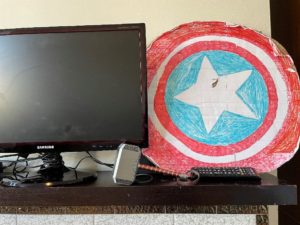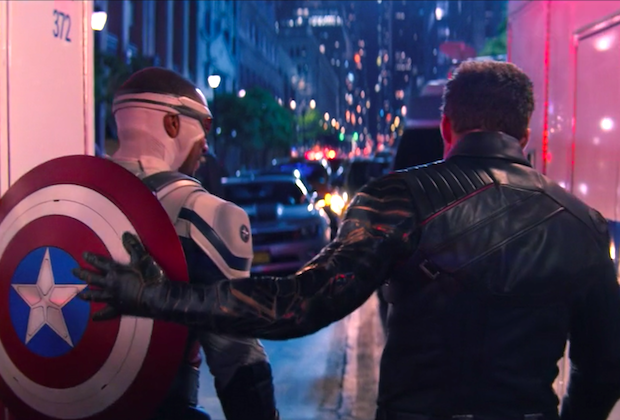Since the start of the COVID crisis, we have a new Friday night tradition at home. We sit down together in front of the TV and watch a movie or a series episode of The Avengers franchise. We take this very seriously. My son dresses in full Captain America uniform with a shield in one hand and Thor’s hammer on the other one. My daughter dresses fully in black, similar to The Black Widow, the franchise main female character. I always wear my gold glove with colour stones (technically called The Infinity Gauntlet) in honour of Thanos, who plays the role of the villain in the franchise.
These days we are watching a series called The Falcon and The Winter Soldier and some of the arguments in the series are surprisingly similar to the arguments of a study that I am completing with Isabel Ruiz on the link between return migration and social cohesion in the conflict context.

Figure 1: Part of the Friday night move set-up
“Blip” Based Identities
In The Avengers story, Thanos (my character), thinks that there are too many people for the resources of the planet. In essence, the typical Malthusian logic. He decides to solve the “problem”, snaps his fingers and half of the global population suddenly disappears. This global event is known as The Blip. Given that Thanos randomly selected half of the population, this is an interesting experiment to understand the broader implications of changes in population size. As you can imagine, hundreds of popular articles have been written about that debate to accompany the extensive academic work on the implications of overpopulation.
There are two common concepts between the series and our research. First, the idea of the creation of placed-based identities that replace, or sometimes are mixed with, other types of previous identities. In the storyline, the half of the population that disappeared is suddenly restored five years later. Five years of absence led to major differences across the groups. Now Blip stayees (did not disappear) and Blip returnees (disappeared and returned) have developed new identities based on their situation during The Blip. Blip stayees got used to the additional availability of resources and greater freedom because of the lower population density. They also had to deal with the massive social chaos that resulted from the sudden disappearance of half of the global population. Blip returnees consider themselves the actual victims of the situation. Their lives were frozen for several years and they are desperately trying to catch-up.
In the series, the return of the disappeared increased social tensions and led to new forms of violent resistance by Blip stayees.
Similarity with Return Migration
In our study, we look at Burundi, a country that has experienced large levels of conflict, out-migration and refugee return in recent years. Stephanie Schwartz conducted several months of ethnographic work in Burundi during 2015 and found that individuals in the post-conflict period identified along “migration-related divisions” (e.g. stayees versus returnees), instead of, or perhaps in addition to, other more traditional identification categories such as ethnicity (i.e. Hutus versus Tutsis). She explains that:
“migration-related divisions not only cut across ethnicity, but frequently divided families where members had lived on either side of the border during the war. As such, migration-related categorizations existed independent of, though sometimes associated with, ethnic categorizations.”
Returnees share the common experience of escaping the conflict, adapting to life abroad, sometimes even growing up abroad, and returning home (with many being forced to return). Stayees (those who did not leave the country during the conflict), on the other hand, can have different perceptions on patriotism, nationhood and deservedness of limited community resources given their role in protecting these resources during the conflict.
These dynamics are important as research suggests that those exposed to conflict tend to behave more cooperatively after the end of conflict. Yet, they also tend to cooperate less with out-group members. Therefore, if stayees and returnees perceive each other as out-group members, this can have important negative effects for post-conflict social cohesion.
The role of natural resources also plays a key role. The large population outflow from Burundi increase land availability for those who stayed behind. Land is a major issue for a country in which fertile land is scarce and the large majority of the population depends on agriculture for their survival. The return of former refugees, and their rights to claim land, can lead to further tensions.
Exploring the implications for social cohesion
In our study, we use a methodology that allows us to study the impact of refugee return on social cohesion in a way that simulates a random level of displacement and return across communities (similar to the effect of Thanos snapping his fingers). This allows us to explore the impact of refugee return on social cohesion, but also to explore how the impact of return interacts with factors such as ethnicity, land scarcity and migration-related divisions.
We will be publishing our study soon along with over 20 other studies from the World Bank exploring the link between forced migration and social cohesion. Stay tuned!
